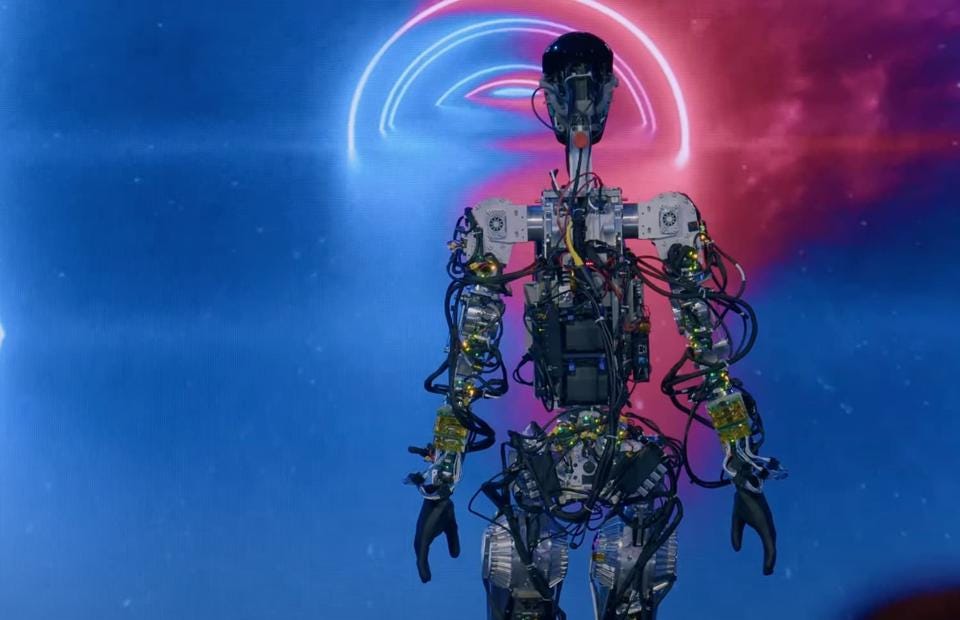The most talked about robot this week
Few thoughts on the Optimus robot shown on Tesla AI day
The most discussed robot this week has been the Optimus shown at the Tesla AI day 2022. There is a lot of press from top media outlets. Most experts in robotics agree that while the demo was impressive in terms of actions from a free standing untethered robot, Tesla has still a lot of room to catch up when compared with state of the art humanoid robots such as those from Boston Dynamics. IEEE Spectrum has a couple of neat articles, covering the demo, and comments from experts.
In this article, we will try to learn what advantages Tesla brings to the field of robotics, and try to understand what competitive advantages does Tesla have, which could make it successful with the Optimus. But first, let’s try to analyze why Tesla and Elon Musk are interested in a humanoid robot.
Why is Tesla investing in the Optimus?
Tesla has two main lines of business: electric cars and harnessing energy. Electric cars is the dominant business, and years of delivering cars at a fast cadence has provided Tesla unparalleled manufacturing experience. The self-driving technology in Tesla’s cars has also given it the capability to train large Machine Learning models and deploy these models in production. Similarly, Tesla has invested close to two decades of experience in building efficient battery technologies which can power the cars. The Optimus is a culmination of the two areas that Tesla is extremely strong at: manufacturing and batteries. Useful humanoid robots also fit in the class of engineering which falls in the category of fantasy in current state of the art technology: similar to how electric cars and reusable rockets were perceived as when Musk first invested in them in the early 2000s. Therefore, Optimus is a great product match for the DNA of Tesla, and we can expect Tesla’s engineering team to be highly motivated to building Optimus.
What are the key strengths that Tesla has for Optimus?
Besides the key tenets of Tesla that have made it very successful: (i) Motivated engineers, (ii) Face of Elon Musk, and (iii) Large amounts of resources (money) to funnel to this project… there are very interesting and unique engineering aspects that Tesla brings to robotics, distinct from the talents that other robot manufacturers such as Boston Robotics have. Let’s visit some of them:
Huge dogfooding opportunity: Tesla, after all might be the biggest consumer and benefitor of Optimus. There are ample opportunities for robots to contribute in Tesla’s Giga factories. Some examples were shown in the AI day, such as an example from the Fremont, CA factory where Optimus was picking items from one bin and placing them to the other. Tesla can test robots at a scale that is unavailable to other manufacturers of humanoid robots.
Strengths in Machine Learning: In its quest for its vision for self-driving cars, Tesla has made deep investments into Machine Learning. The AI day presentation mentioned that the same neural network used in cars was trained for path planning for the Optimus. While the two use cases might be divergent, Tesla’s endeavors into Machine Learning are at a scale that no other robot manufacturer has.
Expertise in batteries: The proposed battery for the Optimus is a 2.3 kilowatt-hour, 52-volt battery pack, which it says can last for a full day. That is certainly a big deal… no robot lasts that long without getting recharged. Just to measure up with examples, the two robots we frequently talk about in this forum, the Anki Vector and Petoi Bittle have a battery life of 40 minutes and 1 hour respectively (Assuming the robot is constantly in operation). Batteries are a major issue for any consumer devices… we all hate charging our gadgets. The battery technology Tesla could bring to robots could certainly be a big game changer.
What are the key challenges that Optimus will face?
The concern is mostly in the Tesla’s ability to define a vision and find real-life use cases which can support a volumn of millions of robots that Musk intends Tesla to manufacture. Boston Dynamics has been very successful in developing robots that can dance and sometimes frighten us, but finding a mass adoption use case (such as the Roomba vacuum robot) has been a major challenge. Musk’s aspires to deliver a humanoid robot within a price tag of $20,000 (which is still very large for most people). Finding a use-case for which a person can shell out so much money is damn hard. I still fancy the $250 Anki Vector robot having more utility for me as a emotive companion that what a $20K bot can possibly have.
The alternative use case could be in industrial settings where there may be room for replacing humans with a robot that comes with a $20K tag. However, industrial use cases are much more difficult to accomplish, and need much higher precision. When it comes to robotics, it is relatively easy to get a robot accomplish a task with 90% confidence. Delivering the last 10% requires the hardest skills and work. While Musk has the ability to deliver his aspirations with sheer perseverance, delivering a useful humanoid robot will certainly rank as one of the most challenging tasks he has taken up.
If you watched the Tesla AI Day and have something interesting to share with us, please add in the comments below.


